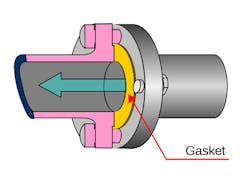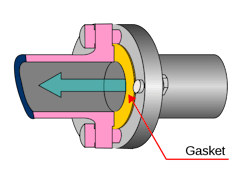Why Is My Face Seal Leaking?
Leaking face seals often show telltale contact patterns that help identify the cause of the leaks. Here are some common signs of face-seal problems.
Symptoms: Seal leaks steadily despite apparent full contact between mating rings. There is little or no measureable wear and a full 360-deg. contact pattern on the mating rings.
Cause: Secondary seal leak caused by nicked, scratched, or porous seal surfaces, O-ring compression set, or chemical attack.
Symptoms: Steady leakage at low pressure; little or no leaking at high pressure. A heavy contact ring on the mating-ring outer diameter (OD) fades to no visible contact at the inner diameter (ID). There could be edge chipping on primary ring OD.
Cause: Deflection of primary ring from overpressurization. Seal face is not flat because of improper lapping.
Symptoms: Seal leaks steadily when shaft is rotating; little or no leaks when shaft is stationary. There are heavy contact rings on mating ring ID; fades to no visible contact at OD. There could be chipping on primary ring ID.
Cause: Thermal distortion of seal faces. Seal face is not flat because of improper lapping.
Symptoms: Seal leaks steadily whether shaft is rotating or stationary. There are two large contact spots and pattern fades between them; contact marks through 270 deg. and pattern fades at a low spot; or contact spots at each bolt location.
Cause: Mechanical distortion caused by: overtorqued bolts; out-of-square clamping parts; out-of-flat stuffing-box faces; nicked or burred gland surface; or hard gasket.
Symptoms: Seal leaks steadily whether shaft is rotating or stationary and noise from flashing or face popping. High wear or thermal distress on mating ring; high wear and carbon deposits on primary ring; and possible edge chipping on primary rings. Or thermal distress over one-third of main ring, located 180 deg. from inlet of seal flush; high wear and possible carbon deposits on primary ring. Or thermal distress at two to six locations on mating ring and high wear and possible carbon deposits on primary ring.
Cause: Sealed liquid vaporizing at seal interface caused by low suction or stuffing-box pressure, improper running clearance between shaft and primary ring, insufficient cooling, improper bushing clearance, or circumferential flush groove in gland plate missing or blocked.
Symptoms: Seal leaks steadily whether shaft is rotating or stationary and there is high wear and grooving on mating ring.
Cause: Poor lubrication from sealed fluid or abrasives in fluid.
Symptoms: Steady leak whether shaft is rotating or stationary. The contact pattern on the mating ring is slightly larger than primary ring width. Possible high spots opposite drive pin hole.
Cause: Out-of-square mating surface caused by nicked or burred mating gland, improper drive-pin extension, misaligned shaft, piping strain on pimp casing, bearing failure, or shaft whirl.
Symptoms: Damaged mating ring and seal leaks whether shaft is stationary or rotating. There are eccentric wear patterns as wide as the primary ring and possible cracks on the mating ring.
Cause: Misaligned mating ring caused by improper clearance between gland plate and stuffing box or lack of concentricity between OD and stuffing-box ID.

